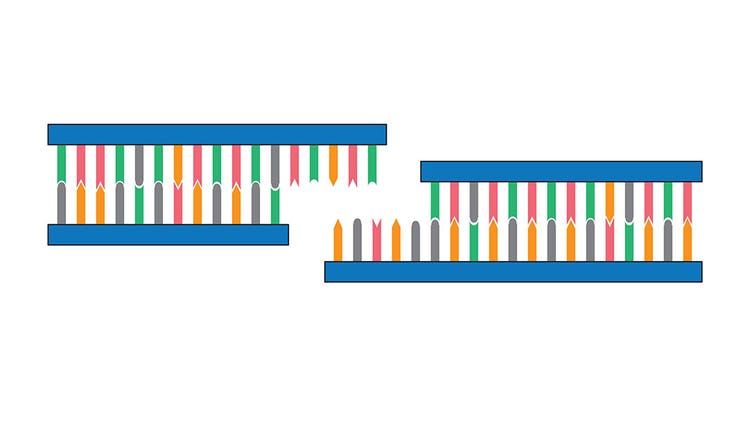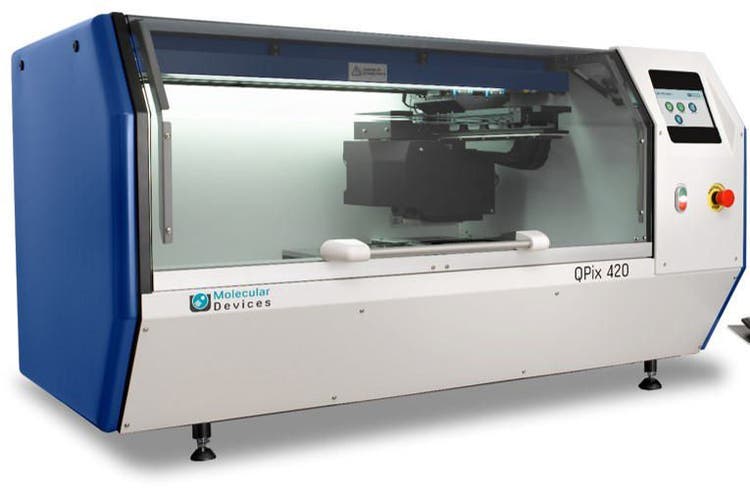What is DNA Ligation?
DNA ligation is the process of joining two strands or fragments of DNA molecules through a phosphodiester bond formed by the enzyme DNA ligase. DNA ligase is involved in maintaining the structural integrity of genomes by participating in DNA replication or repair processes.
DNA Ligation Mechanism
The mechanism of DNA ligase reaction consists of three steps:
-
Ligase attacks the alpha phosphorous of ATP or NAD+ and releases PPi or NMN. This leads to the formation of a covalent ligase-adenylate intermediate, where AMP is linked to the lysine molecule.
-
DNA adenylate forms by the transfer of AMP to the 5’-end of the DNA strand.
-
Ligase catalyzes the reaction of joining the polynucleotides and liberating AMP by attacking the 3′-OH of DNA-adenylate nick.
Types of DNA Ligase
Mammalian DNA ligase:
The enzyme is categorized into four groups, DNA ligase I – IV.
T4 DNA ligase:
It is found in bacteriophage T4 and mainly involved in blunt end ligation of DNA fragments or DNA-RNA hybrids. The enzyme is extensively used in lab workflows and often modified using genetic engineering techniques for enhanced in vitro activity.
E. coli DNA ligase:
It is encoded by the lig gene and performs efficient ligation on cohesive ends of nucleic acid fragments.
Thermostable DNA ligase:
An essential reagent in PCR workflows, this ligase, isolated from a thermophilic bacterium, remains stable at extremely high temperatures. Taq DNA ligase is one example.
See how Danaher Life Sciences can help
DNA Ligation Reactions
DNA ligation reactions are characterized by the ends created through restriction enzymes as noted below.
Blunt-End Ligation:
In this reaction, blunt ends generated in plasmid vectors and DNA inserts facilitated by restriction enzymes are joined together with DNA ligase by forming a phosphodiester bond. This type of reaction is less efficient compared to sticky-end ligation.
Sticky-End Ligation:
The restriction enzyme cuts the plasmid vector and sequence of DNA inserts at two different positions, resulting in short single-stranded overhangs at both the 3’ and 5’ ends of the nucleic acid fragments. The different lengths of overhanging ends generated in DNA fragments are known as DNA sticky ends and must be complementary for the ligation to be successful.
DNA Ligation Applications in Molecular Biology
DNA ligase enzyme repairs ssDNA or dsDNA breaks during DNA replication. In molecular biology labs, it is extensively applied for cloning and genetic modification experiments.
Molecular Cloning
Molecular cloning is a technique used in labs to create recombinant DNA with the aid of ligases and restriction enzymes. During the process, a plasmid vector and target DNA sequence are cut using a specific restriction enzyme and then joined together through DNA ligases. The recombinant plasmid is then introduced into a host cell or organism (typically E. coli) to multiply before being purified for downstream applications.
Gene Synthesis and Assembly
During synthetic DNA synthesis, DNA ligase joins nucleotide fragments to develop synthetic oligonucleotides that are applicable for multiple research or therapeutic purposes. Some applications include library preparation for genome sequencing, in vitro gene expression assays, or in vivo gene silencing.
Featured Product
DNA Ligation


QPix® Microbial Colony Pickers
Automated microbial screening system capable of picking up to 3000 colonies per hour.
Troubleshooting DNA Ligation Reactions.
Troubleshooting a DNA ligation reaction is the only way to ensure successful DNA ligation. Here are some tips to help you in the process:
- DNA fragment quality check - Check the quality and concentration of the DNA fragment sample. Make sure the molar ratio of DNA fragments for ligation is optimal.
- DNA ligase concentration - Verify the concentration of DNA ligase enzyme for the specific DNA ligation reaction.
- Reaction parameter optimization - Optimize the reaction parameters, such as temperature, extension time and ionic strength of standard ligation buffer for efficient reaction.
- Reagent handling tips - Handle all the reagents, such as ligase enzyme, ATP, and the sample, carefully to maintain their integrity and activity for the ligation reaction.
Quality Control and Analysis of Ligated DNA
Joining of fragments is the primary function of DNA ligase enzymes in DNA replication, recombination and repair. This function is extensively exploited for in vitro applications by researchers, especially for gene editing. Thus, it is of paramount importance to assess the ligase enzyme activity and percentage of ligation success in experiments.
Ligation Products Verification Methods
Ligation products can be verified using a range of molecular techniques, such as agarose gel electrophoresis and PCR. Some other methods used to assess ligations include capillary electrophoresis and an enzymatic bioluminescent assay. Further, sequencing techniques, such as Sanger Sequencing and Next-Generation Sequencing (NGS), are used to validate ligated products.
Future Trends in DNA Ligation Techniques
DNA ligation is a crucial step in many biological processes, such as DNA replication, recombination and repair. Since the discovery of the DNA ligase enzyme, it has become an essential component for building recombinant DNA or inducing site-directed mutagenesis for further studies. Emphasis is being placed on continuing to develop stable ligase enzymes that possess greater efficiency and accuracy. The reduction of GC bias and end joining mismatch are optimal features.
FAQs
What are the enzymes involved in DNA replication?
The enzymes involved in DNA replication include DNA ligase, DNA polymerase, DNA helicase and topoisomerase.
In what direction is DNA synthesized?
DNA is always synthesized in a 5'-to-3' direction by the DNA polymerase enzyme.
What is the role of DNA polymerase during DNA synthesis?
DNA polymerase is responsible for adding nucleotides to the growing strand of DNA for its efficient replication. Thus, it is a primary enzyme involved in synthesizing new DNA strands in the 5'-to-3' direction.
What is the role of DNA ligase during DNA replication?
In DNA replication, DNA ligase is responsible for joining the two DNA fragments by forming a phosphodiester bond.
Why is ligation an important step in gene cloning?
Ligation is one of the crucial steps in gene cloning because the DNA ligase enzyme joins a DNA vector with the target gene sequence through their blunt or sticky ends.